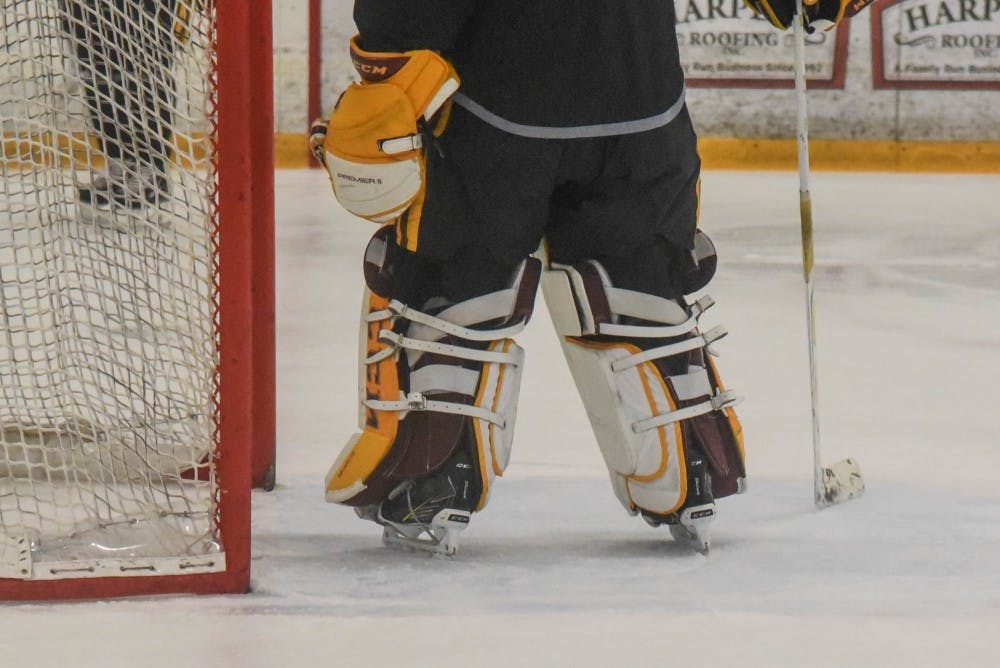Hockey in the Valley is becoming more and more commonplace. No place knows that better than the Oceanside Ice Arena in Tempe, which first opened its doors to the public in 1974.
The arena is a frequently-used building,and has been the home of ASU hockey since 1985. It now hosts both ASU’s men’s and women’s hockey teams as well as other teams/leagues.
Outdoor climate and frequent use
Arizona visitors and residents can frequently expect dry and hot weather during a good portion of the year, with daytime temperatures in the summer typically climbing into triple digits.
“What we found in our hybrid year (is) we practiced at 2 p.m. — after both club teams, the ice is pretty beat up,” men’s hockey head coach Greg Powers said. “But when we moved our practice back to 9 a.m., the ice is in good condition for us every morning and (is) not an issue.”
Brad Priest has been the director of facility operations for the last seven years at Oceanside Ice Arena. Priest wrote in an email interview that he is a former hockey player and developed a passion for arena management and ice operations, working in the industry for more than 20 years.
“Ice quality is a measure of constant temperature,” Priest wrote. “Regardless of the outside temperatures, the arena's mechanical ice plant is monitored and controlled to offset ambient temperatures to maintain a consistent ice surface within a range of 20-22 degrees.”
Priest explained that this provides a safe and consistent ice surface for the NCAA team, in addition to keeping the ice in good condition for others using the arena's facilities.
NCAA and Oceanside
Priest wrote that maintaining the ice is all about three things: safety, performance and timing.
“First and foremost, we ensure the players are skating on a playing surface that is safe in conjunction with its attentive structures ... boards, glass, etc,” Priest said. “Then we want to make sure the ice is performing to NCAA standards. Last, our in-game maintenance meets the teams needs in a timely matter according to NCAA requirements.”
The breakdown
When game day arrives for the ASU men's hockey team, Priest said his team spends more time than normal preparing the ice.
“For a 7 p.m. game, general ice programming concludes at 5 p.m.,” Priest said. “This allows for all the necessary pregame work to be facilitated in a timely fashion.”
Priest provided a detailed breakdown of the logistics for preparing the Oceanside Ice Arena’s rink for NCAA competition.
Maintenance of the ice begins two hours prior to puck drop.
The first step involves hand edging the ice that connects with the boards (or edges) of the rink with a small blade on a handle. Priest wrote that this is done to “clear out any rough ice that might impede puck play/bounce off the boards.”
The second step, Priest described, calls for drilling holes into the moorings in the goal crease. The holes in the ice hold the pegs in place which, in turn, hold the goal in place.
Part three of the process involves two rounds of strategic “flooding,” prior to team pregame warmups.
“We want the team to start on a fresh surface that is completely free of any skate grooves,” Priest wrote. “We essentially use the same protocol that's used for an NHL game.”
Finally, the last component of the ice preparation involves dropping the ice plant temperature to accommodate for the heat increase when the arena is at full capacity.
"This is the most vital aspect to get right ... the amount of temperature and the timing of it,” Priest wrote. “Our experience in this area speaks for itself.”
ASU sophomore goaltender Joey Daccord noted that when the venue is at full capacity, the ice can get “chewed up” quickly.
“Because it’s so small, when it’s packed … it gets really hot and the ice gets chewed up really fast,” Daccord said. “Honestly, they do a really good job here keeping up with it.”
Reach the reporter at michael.baron@asu.edu or follow @Michael_Baron96 on Twitter.
Like State Press Sports on Facebook and follow @statepresssport on Twitter




